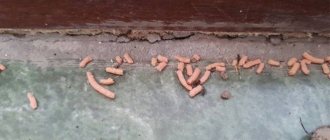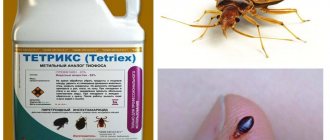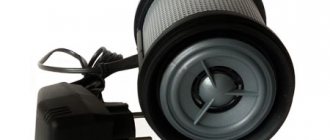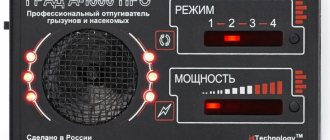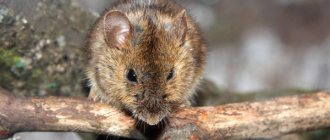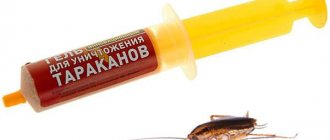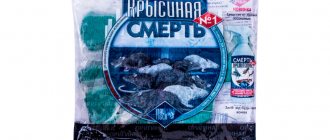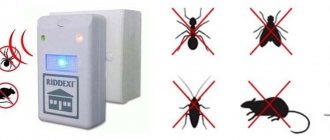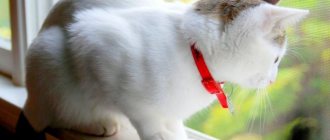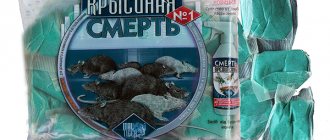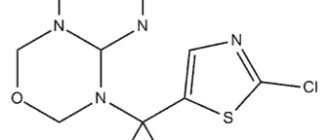Rodents that have settled in the house and domestic premises can cause significant harm. The danger comes from parasites and infections carried by mice. When there is a large concentration of individuals, mouse poison helps effectively combat the invasion. Poisonous agents guarantee physical destruction and cleansing of the home from uninvited guests.
- Types of poisons Blood anticoagulants Rat death No. 1
- Goliath
- Storm
- Rat Death #2
- Efa
- Zookoumarin Neo
- Fumiphos
- Rat Death #1
The principle of action of rodenticides
Rodenticides are all chemical agents used to control rodents. Some poison pests when they enter the stomach, others (fumigants) act by inhalation. Fumigation products produce a gas that is heavier than air. It spreads along the ground and penetrates rodent burrows.
Principles of action of toxic substances:
- Zinc phosphide produces a toxic gas (phosphine) that can poison rodents.
- Chlorine and other asphyxiating gases cause acute asphyxia.
- Krysid disrupts breathing processes.
- Phosphine disrupts metabolism and paralyzes the nervous system, producing an acute and rapid toxic effect.
- Anticoagulants reduce blood clotting, causing increased bleeding in the animal, leading to their death.
Products based on flocumafen
Of all the blood anticoagulants, flocumafen is considered the most effective today. Compared to analogues, the dose of this substance, lethal for rats and mice, is minimal, and therefore it is possible to poison rodents with drugs based on it faster and with less cost of the drug itself.
On a note
The principle of action of flocumafen (like other blood anticoagulants) is that it blocks the production of proteins in the body that ensure blood clotting. When a rat receives a sufficient dose of the anticoagulant, it develops extensive hemorrhages in the lungs and intestines, due to which it dies.
Perhaps one of the most famous and widespread rat poisons based on flocumafen is the rodenticide Storm produced by BASF (UK). The drug is very inexpensive: a package of 4 briquettes costs about 30 rubles.
It is also useful to read: Rules for choosing the best ultrasonic mouse and rat repeller
Let's do the math: each briquette weighs 4 grams, and 1.5 grams of the product is enough to kill one adult rat, and 0.8 grams for a mouse. It turns out that one 16 gram package of Storm is theoretically enough to kill 10 rats or 20 mice. And although in reality the consumption of the drug turns out to be large (after all, many rats manage to eat more bait before dying than they need for poisoning), Storm still turns out to be a very economical remedy.
The photo below shows the packaging of the drug Storm:
Typically, rats begin to die approximately 3-4 days after they try flocumafen-based poison for the first time. In practice, rodents disappear from the premises within 7-10 days after the bait is first laid out - many animals do not immediately find it, some of them “taste” the poison in small portions for several days.
An analogue of Storm is Goliath, a remedy for rats and mice, but this drug is sold only in large packages (in buckets of 1 kg), costs much more and is generally noticeably worse presented on sale.
Review
“We needed two packs of Storm. Well, what can I say, it’s a good poison, I have no complaints about it. I don’t know, maybe our vigorous rats are more resilient than refined ones from abroad, but only this creature ate four tablets and continued to shit. We bought another pack, she swallowed four more pieces, as if she didn’t even notice. And only then she disappeared. But still, 60 rubles is not such a big price to get rid of this disgusting thing...”
Alena, Moscow
Comparative analysis of first and second generation poisons
For deratization, anticoagulants of the first and second generations are used. First generation anticoagulants accumulate in the body with repeated use with food or water additives. They are most effective against rats and voles. Drugs in this group include ratindan, ratifen, reacid, zoocoumarin, zeracid.
Rat poison for mice and rats: how it works and which is the most effective, read the article here.
Second generation anticoagulants are effective in killing any rodents at very low concentrations; death occurs after the first use. These include rodeffacoum, rodialon, geldan.
It is important to know! Rats are very smart. If they notice that their relative has died from the bait, then no one else in the population will eat it. Therefore, when fighting them, it is better to use poisons with delayed action.
Classification of drugs
There are several forms of release of drugs against rodents. They differ in their principle of action, concentration and method of distribution. Among them:
- Granules and powders. They are mixed with food products. Once in the gastrointestinal tract of a rodent, they poison the body.
- Liquid products. They process food products that are attractive to rodents.
- Pills. Contains flavoring and aromatic additives that attract rodents.
- Aerosols and sprays. They are applied to surfaces on which pests can move. Spread by contact.
- Cream or gel preparations. They have a higher concentration of toxic substance.
According to the principle of action, all types of poisons are divided into two types: instant and prolonged action drugs.
The former are a fast-acting remedy, the disadvantage of which is the danger to pets and its obvious effect. Rats are very smart, they are able to associate the death of a relative with eating a certain type of food and will avoid bait.
Long-acting poisons work differently. They are contained in the bait in minimal quantities, due to which their effect occurs much later, and the rat or mouse does not associate the death of its relatives with eating the product. Pests will not avoid the bait and will eventually receive a lethal dose of the drug. In addition, due to its low toxicity, the product is not dangerous for pets.
The anticoagulants contained in the application, penetrating into the animal’s body, reduce the production of platelets, causing serious blood clotting disorders. This provokes massive internal hemorrhages and death from blood loss. Anticoagulants can act quite quickly, but only if a lot of the drug has entered the body. Basically, they cause the death of a rodent 2 weeks after entering the body. By this time, the animal’s tissues have accumulated a sufficient amount of anticoagulant.
Release forms
There are different poisons that can be used to poison mice and rats. Both concentrated preparations for preparing baits yourself and ready-made products are available. They are produced in the form of briquettes, granules, gels, processed grains and seeds, powders, flakes, liquids, pastes.
It is important to know! Any bait must be placed in places inaccessible to children and pets.
Blocks
Most often, it is foreign manufacturers who produce baits in the form of solid nodules - blocks. They can be large or small, with or without holes for threading onto rods.
Granules
The crushed grain mixture with the addition of a chemical is formed by an extruder into solid granules, similar to compound feed or dry dog food. This form is preferred by mice, although rats will also eat them.
Bruschi
Ready-to-use solid nodules in the form of bars usually have foreign preparations. Manufacturers recommend placing them in special stations.
Corn
Crushed or whole grains, cereals, and their mixtures are coated with poison and painted in bright colors. This form is more suitable for poisoning mice.
Liquid poison
Liquid solutions of active ingredients in water, oil, alcohol or ethylene glycol are more effective in fighting rats, especially if there are no easily accessible sources of water nearby. But there is not always such a hard-to-reach place where a saucer or bowl will fit.
Gel
The rodenticide in the form of a gel is produced in two types:
- ready-to-use drug;
- concentrate for making your own baits.
Effective against rats, mice and voles. The ready-to-use drug may leave marks on the surface to which it was applied. Therefore, it is recommended to place it on substrates made of thick paper, polyethylene, or plastic.
Powders
The powders consist of wheat, oat or barley flour mixed with a blood anticoagulant and a small amount of sugar. They are effective for most objects, but you need to prepare poisoned baits yourself. When mixed, they generate dust, and this is dangerous for humans, so they must be handled with extreme caution.
Soft briquettes
The texture of soft briquettes resembles dense dough. Rats like them because they look like meat. Convenient to use. They are painted in bright colors, distinguishing them from ordinary food products.
Interesting! Rats usually have a preference for animal products.
Advantages and disadvantages of using poison
It is impossible to destroy large families without using poisons. The choice of drugs is large, but before you buy a specific drug, you need to remember the existing advantages and disadvantages of each of them. In general, these are the following points.
Advantages:
- High reliability even after single processing.
- In difficult cases, you can invite deratization specialists who have the technology to work with strong poisons.
Flaws:
- Toxicity of drugs.
- The need to comply with all precautions recommended by the chemical manufacturer.
- Carrying out activities related to the preparation of premises. Removal of pets, people, organization of temporary housing for them. Cleaning the room after the etching process.
Review of effective remedies
You can get rid of pests using chemicals. Some act instantly, while others have a delayed effect. Some manufacturers point to the mummifying effect and the absence of an unpleasant odor from the decomposition of the body.
20 most effective rat repellents - tablets and poisons
Interesting to know! Information about mummification stated by manufacturers is not entirely true. In fact, anticoagulants cause suffocation in rodents, which causes them to run out into the fresh air, where they die.
Rat death
This dough-like poison for rats and mice, colored in colors uncharacteristic for food products. Packaged in small briquettes. Effective for killing rodents in private homes. The drug has a delayed mechanism of action. The rodents die 3-4 days after eating the bait. The product contains antimicrobial and antimicrobial ingredients, so it has a long shelf life.
Help
Briquettes for killing rats and mice Help are suitable for use in a private home, sheds, warehouses, basements or barns. The drug kills slowly. This requires several techniques.
Ratron
Granular bait for rats and mice is recommended for use in residential, agricultural and industrial premises. Portion sachets provide convenient, simple and safe use. One dose is enough, after which the rodents die within 4-7 days.
Tomcat All Weather Bait Chunx
Blocks of this bait, packaged in buckets, have holes for stringing onto metal rods in stations. Used for effective extermination of rats and mice in everyday life. The action is fast.
Attention! Using poison stations for mice and rats in your home will keep your pets safe.
JT Eaton 709-PN
These green bait blocks with a peanut butter scent are effective in killing mice and rats. Convenient to use. Recommended for use in warehouses, retail facilities or other industrial enterprises, but also suitable for a home or apartment.
D-Con Ready Mix Baitbits Mice Rats Brodifacoum 3oz (1 Tray)
A set of trays with baits for mice and rats. They will also work on moles, squirrels, rabbits and gophers. Each box contains four trays.
Farnam Home & Garden Just One Bite II Bar
This rat poison is released in blocks that are lined so that they can be divided into 8 small parts. Suitable for baiting mice and rats. Convenient for home use. Fast-acting. One dose is enough to achieve results.
Havoc Rat & Mouse Bait Havoc
The rodenticide is available in double packs of granules. Works effectively on rats and mice. The effect occurs with a single dose. Suitable for home use.
Fumiphos, Alphos, Magnikum
Highly effective fumigants for pest control of stocks. Effective for killing insects - pests and rodents. Available in the form of tablets, packaged in metal bottles. When the tablets come into contact with air, phosphine gas is released, which, causing paralysis of the nervous system, leads to the death of pests. They are prohibited from being used indoors.
Storm
The rat baiting agent Storm is available in the form of blue wax briquettes. It is used in everyday life and by pest control services. A single-use, effective rodenticide that is readily eaten by rats and mice. Leads to their rapid destruction.
Nutcracker
A drug for exterminating rats and mice in residential, industrial and non-residential premises, and in areas around them. It looks like dark blue or red plasticine. Packaged in small filter bags. The product causes death in rats and mice for 4-8 days.
Goliath
This rat and mouse control product is packaged in buckets. Used by pest control services. Suitable for use at home. Rodents die 3-5 days after eating Goliath.
Clean house
Granular rodenticide allows you to effectively poison rats and mice. Provides rapid destruction of rodents.
Mortorat
This poison is for mice and rats with a mummifying effect. Sold in the form of soft briquettes. The effect of the drug occurs on days 4-6. In this case, the dead animals are mummified and do not emit unpleasant odors.
Zookoumarin NEO
The drug Zookoumarin NEO is positioned as a mouse poison. Available in the form of grain bait or granules, colored pink-violet. Destroys mice, voles, and other mouse-like rodents in everyday life and at work.
Hedgehog
This rodenticide is a concentrate in the form of a pink or blue powder. Designed to combat gray rats and house mice. The preparation of bait by the public is not permitted. Used in residential and non-residential premises. It has a pronounced cumulative property, which leads to poisoning if used systematically.
Ratindane
Rodent control agent (rats, mice). Must be mixed with benign food products. Only allowed to be used by professionals.
Zernotsin
Available in the form of orange grain bait or pink granules. The product is used in and around residential buildings, industrial and agricultural buildings.
This is interesting! Rodents do not have color vision, so bright baits do not scare them away. Manufacturers paint the poisoned product in colors not typical for food products for human safety.
Tsunami-extra
Ready-to-use bait is produced in the form of a waxed briquette, dough briquette, granules or grain, painted in a bright color. Designed for exterminating rats, house mice, voles and other mouse-like rodents. Used by professional disinfectors and the public at home.
Warat
This drug is intended to combat mouse-like rodents. Single action. The death of pests occurs 4-6 days after eating the bait. Used both outdoors and indoors. Suitable for home use.
Krysid
Rat venom is used to prepare poisonous baits. This is a highly effective product in the form of a black powder. Has an immediate effect. The death of rodents occurs within 1-2 minutes. It works after use in small doses. It is a cheap and effective remedy. Use by the public is permitted.
Brodifan
The liquid is bright red. Concentrate for preparing bait that can be used to poison rats and mice. Allowed for use in residential premises.
Three cats
Rodent repellent in the form of green dough-cheese ready-made bait briquettes is another mouse repellent! The death of rodents occurs 3-6 days after eating the bait once. Suitable for home use.
Attention! There are no rat poisons that are harmless to your pets!
Mechanical traps
These products are simple, cheap, effective, but very troublesome to work with and do not provide such massive destruction of rats as poisons can boast.
The most primitive and simple trap kills one rat and after that requires recharging - until the dead rodent is pulled out of it, it will not kill a new one. As a result, it is extremely difficult for them to catch a hundred or a thousand rats, which means that this is a remedy for a small room, including at home, including in a country house, in a basement, or in a barn.
The advantage of such traps is the controllability of their work. It is quite obvious from the trap whether it worked or not, whether it killed the rat. Moreover, if a rat lives alone in a certain room, a trap is enough to solve the problem with one trigger.
There are trap options designed to catch and kill several rats in a row. Such structures include homemade traps - buckets and boxes with tilting bridges, into which many rats can fall without reloading. But they have no talk about scale: at best, such a trap can catch several dozen rodents. Hundreds and thousands of pests will not be caught in it in a short time.
In addition, the traps are quite safe. Even spring squeezers can be made harmless by simply placing them in a cardboard box with a hole that a cat cannot fit through. In modern containers with such crushers, the trap itself is even fenced off with a partition, into which a particularly curious cat cannot even put its paw. And the rat will climb in without any problems.
These same traps are inexpensive. The simplest rat traps cost 100-150 rubles, more technically advanced ones cost up to 500, which is still quite acceptable.
One such trap can serve faithfully for years, killing hundreds of rats during this time.
And one more non-obvious advantage of such devices: a rat killed in a trap will not run away, die or stink somewhere behind the drywall, or in a ventilation duct, from where its mercilessly stinking corpse cannot be pulled out without the need for repairs.
We use such traps in private homes, in the basements of apartment buildings, in offices, and administrative buildings of enterprises. For home use, this is perhaps the best option.
Best bait options
Pesticides and biologists know that rats prefer animal products, and mice prefer plant foods. Despite this, mice are often caught in traps with a piece of lard or meat, and rats - with grain or fruit.
16 best ways to make a rat trap with your own hands
Peanut butter
Rats enjoy almost all types of sweet foods and nuts. So, peanut butter is sure to attract rodents.
Chocolate
The bittersweet smell of chocolate will lure both mice and rats into the trap. If there is no chocolate, then you can use any other product containing cocoa.
Bread
The crust of fresh bread, sprinkled with vegetable oil (it is better to take unrefined - it smells strongly), attracts both rats and mice.
Ropes, cotton wool
Scraps of rope and cotton wool can be excellent materials for bait. Rodents strengthen and insulate their nests with them.
It is important to know! When laying out baits, it is not recommended to touch them with bare hands. The scent of a person left on them will repel rodents.
How does poison with anticoagulants work?
Despite the absence of mummifying agents in the compositions, anticoagulants speed up the drying process of corpses. An anticoagulant is a drug that interferes with blood clotting and prevents the formation of platelets. The impact on the body causes profuse internal bleeding - severe blood loss significantly reduces the percentage of fluid content, the corpse dries out much faster. It is this effect of anticoagulants that manufacturers of mouse poison present as mummification.
Individuals that have eaten bait with poison return to the nest and slowly die within 10 days. Due to the low moisture content, the tissues of the corpse dry quickly, there is no smell, the problem of decomposition is eliminated, the owner is satisfied. Moreover, rats do not associate effect and cause, and since the animal does not emit an odor, the bait can be scattered again until the next generation of rats with immunity to poisons grows up.
Folk recipes
There are various traditional methods of getting rid of rats and mice. The simplest solution is to get a rat-catcher cat. If you have a garden plot, vegetable garden, pigsty or chicken coop, this is the best way to fight rats. An alternative to a cat can be dogs - fox terriers or dachshunds. If this is not possible, you can use simple folk recipes.
Gypsum
Gypsum is added to the milk until it reaches the consistency of a batter. When it enters the stomach of a rodent, the gypsum thickens and clogs the intestines, causing obstruction. Because of this, the animal will die after some time.
Wine cork
Cork powder mixed with flour or any cereal swells in the rodent's stomach and clogs the intestines. This leads to obstruction of the digestive tract and death of the rodent.
Quicklime
Quicklime mixed with sugar or ground cat food. It is mistakenly believed that the rodent dies from an increase in temperature when slaking lime in the stomach. In fact, quicklime corrodes its walls. This leads to inevitable death. However, due to the characteristic taste, pests often avoid such bait.
Baking soda
A mixture of baking soda with flour and sugar, diluted to a dough-like state with water, is readily eaten by rodents. In the body of rodents, soda causes a burn to the mucous membranes and produces a gas that poisons the body from the inside.
Crushed glass
Finely crushed glass is mixed with butter dough and baked. Broken glass damages the gastrointestinal tract, causing rodents to soon die.
Chilibukha tincture
Chilibukha tincture added to milk or soup is very poisonous, but has a characteristic odor that often repels rodents.
Interesting! Scientists have concluded that rats are able to adapt to various poisons and also recognize them.
How to prepare poison for mice at home
You can create an effective remedy for fighting mice at home using one of the recipes:
- Mix the crushed grain with dry alabaster in equal proportions and place it in a place where mice often appear. Be sure to place a bowl of water nearby - after the meal, the rodent will drink water, and the powder will harden in the stomach, leading to death;
- mix lime and sugar - when the composition enters the stomach, a reaction begins, leading to the death of the mouse;
- mix flour and baking soda in equal proportions (150 grams each) and add 100 grams of granulated sugar. After entering the digestive system, the composition reacts with gastric juice and active formation of carbon dioxide occurs. As a result, the rodent dies due to the active production of gas in the body.
How to use it correctly
The finished bait should be used according to the manufacturer's recommendations. Depending on the size of the room and the number of rodents, the poison is laid out in small doses at a distance of 3 to 10 meters from each other. It is recommended to place bait near holes, near water sources. It is better to do this in the evening, because rodents are active at night. To enhance the effect, it is better to place rodenticides directly into the burrows.
To ensure safe use you need:
- isolate the premises from children and pets;
- put on gloves and a cotton-gauze bandage;
- Be sure to wash your hands after contact with the drug;
- You should also wear gloves when removing dead rodents;
- bury them and the remains of the drug in the ground to a depth of about 1 meter.
Plastic container for mice
In order for poisoned baits to have maximum effect, special plastic bait containers should be used. They are used by pest control agents.
Their advantages:
- the poisonous bait is protected from atmospheric influences (wind, rain);
- equipped with a drinking bowl and a special place for poison;
- To attract the attention of rodents, the entrance resembles a hole.
Poison reserves can be easily and conveniently replenished; this is exactly what the design is designed for.
Precautionary measures
Chemicals are dangerous to humans! Therefore, when working with them, it is important to observe the following precautions:
- Pregnant and lactating women, children and persons who have wounds or abrasions on their hands are not allowed to come into contact with poisons.
- It is necessary to wear protective overalls or a gown, rubber gloves and an apron, a respirator or a cotton-gauze bandage.
- Make solutions in enamel containers that are not used for other purposes.
- If you come into contact with poison, do not smoke, eat or drink.
- Store unused preparations and prepared baits out of reach.
- After work, wash the dishes and table with a 2% soda solution. Wash your hands with soap, wash your face, and rinse your mouth with water.
- Throw the remaining bait into a hole about 1 m deep, away from living quarters.
Krysid and its properties
The chemical name for rat is alpha-naphthylthiourea (abbreviated ANTU). The principle of action of this poison is a sharp decrease in the concentration of hemoglobin in the blood, as a result of which the animal dies from suffocation.
Ratsid and products based on it are quite effective against rodents, but have several disadvantages:
- Rats and mice quickly develop resistance to this poison, and therefore using it without alternating with other means is ineffective;
- Preparations in the form of processed grains and powders generate dust, so the poison can enter the human lungs with the air and lead to poisoning.
Because of these disadvantages, Ratside is used less and less today and is quickly being replaced from the market by more effective drugs based on blood anticoagulants. It is not recommended to use it at home.
Review
“As far as I remember my childhood with my grandmother, she always poisoned rats with Rat. Now I called her and asked, and she says that this is the most powerful poison for rats. Now the question is: where can I buy it? I went to neighboring stores, they weren’t there, I called stores in Moscow - they don’t stock it either. I tried to order from several online stores, but they don’t sell it. Maybe it's called something else now? Still, I would like to buy something that really works against rats, otherwise there is somehow no trust in modern products..."
Masha, Domodedovo
It is also useful to read: Which rat and mouse repeller is better: a review of devices and reviews about them
Tips and tricks for choosing
When choosing a suitable drug, you need to consider:
- rodent species;
- habitat of the population (office, apartment, private house, summer cottage);
- their number.
Based on this information, the appropriate drug is selected. So, for an apartment or office it is more convenient to use rodenticides with a mummifying effect. If there are a large number of rodents, it is better to choose a fast-acting remedy.
The most effective poisons against mice and rats: Nutcracker, Ratindal, Storm, Tsunami, Rat Death. The popularity of these products indicates the excellent results achieved with their use.
Rules for the use of poisons
When carrying out pest control, you should follow basic safety rules.:
- When laying out mouse poison, which is dangerous for humans, you should wear gloves, and, if possible, a respirator or protective suit.
- When working with volatile materials that may become airborne, keep all pets and small children away from the handling area.
- Mouse baits should not be scattered directly on the floor; it is better to place them on plastic backings.
- The poison is laid out in places where rodents are expected to live (near burrows, on travel routes, in places of shelter, along walls). The amount of bait depends on the area of the room.
- Mice carcasses should be removed immediately to prevent the spread of a putrid odor and also to protect pets who may gut the poisoned pests.
Modern mouse poison is highly effective, easy to use, and affordable. If proper safety measures are observed, deratization will not take much time and effort.
Prohibited poisons for rats
In addition to arsenic compounds, there are other known, generally effective, but prohibited poisons.
Among them:
- Thallium salts (in particular, sulfate). On its basis, the drug Celiopast was produced, but it is currently withdrawn from sale and is not produced. In some countries, the use of thallium sulfate is prohibited altogether. And in general, it is unwise to replace more affordable and no less effective blood anticoagulants with them;
- Yellow phosphorus is a very toxic substance that can cause severe burns and lead to the death of an animal after a single consumption. Banned worldwide by various conventions, including the Berne Convention of 1906;
- Lead-based preparations. They were rarely used purposefully as a rodenticide - the main difficulty in their use was that rats quickly recognized the poison and did not eat it. At the same time, acute lead poisoning in rats has been well studied in medical experiments. These experiments showed that lead compounds can be effective rodenticides, but in real conditions they are inferior to blood anticoagulants in many respects and are not used in practice.
Many substances are also known that are toxic to rats, but are not used in poison formulations. In particular, the signs of sodium nitrite poisoning in rats and the toxic effect of mercury and cyanide compounds on them are well described. However, due to their high toxicity to humans, these substances have not found practical use.
Zinc phosphide and preparations based on it
This remedy is even more dangerous than Krysid. When it enters the stomach of a rat (or any other mammal), zinc phosphide reacts with hydrochloric acid to release highly toxic hydrogen phosphorous (phosphine), which leads to the death of the animal.
Even just in air, zinc phosphide slowly reacts with water vapor with the gradual release of phosphine (where the drug is located, there is always a specific smell in the air). For this reason, it is unacceptable to use this substance in residential areas.
Preparations based on zinc phosphide - Ratox and Commando. They are used only in enterprises not related to the food industry.
